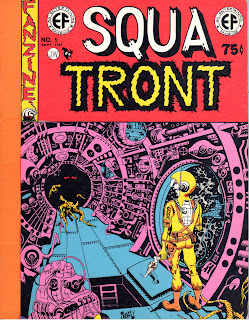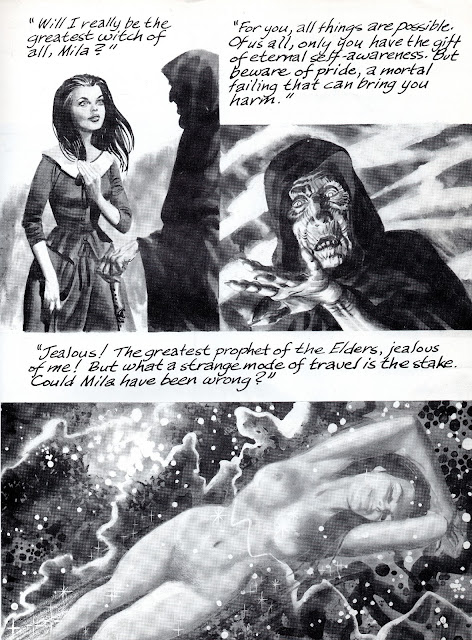
The late Jerry
Weist's original "SQUA TRONT" is the the ultimate EC Fanzine, and is
probably one of the most legendary fanzines to ever be published. Part
of its success was rooted in that it pooled efforts country-wide from
very talented fans that had spent the ten-plus years after the EC
comics' demise getting deeper into the comics world, and deeper into the
world of EC itself. The other part of SQUA TRONT's success can be
attributed to Weist himself, whose fanatical passion is evident
throughout the issues he edited (and even after he left). The lay out
was tight, meticulously designed; and the days of the mimeograph were
almost distant in the past.
The
cover for the first issue was drawn by the talented young Roger Hill,
who's name, like Weist's, still comes up frequently when people talk
about EC Fandom and Fanzines (both, as well as most connected to SQUA
TRONT, have gone on to create and contribute work in the field of comics
and beyond). It's Hill's take on Wally Wood's style, natch.

Another great illustration from Roger Hill.



Excellent depictions of the GhouLunatics by Rick Showalter, with neat psychedelic lettering.

Wonderful EC SF border by Roger Hill.

Al Williamson is one of my favorites. He looks particularly cool in this photo.

From Al Williamson's sketchbook.
All three illustrations by Roger Hill for a Graham Ingles article.
Superb Al Williamson cover to SQUA TRONT #2.
I LOVE this back cover illustration for SQUA TRONT #2 by Reed Crandall.
By George Metzger.
Fascinating tale of two young fans visiting some EC celebrities! Great photos ...
By Lance de Lipski.
This painting of the Vault Keeper by Johnny Craig hung in Gaines' office. It was also used as the cover for SQUA TRONT #5
Wow! Another painting by Johnny Craig; used as the back cover of SQUA TRONT #5.
Really cool, early "Ghastly" Graham Ingles.
No
one can ever accuse the EC gang of not having a sense of humor! The
photos were taken by young Paul Kast in 1951 while Al Feldstein was
applying make-up and costume to Johnny Craig for some EC mail order
glossies of the GhouLunatics!
Great bio piece by Roger Hill.
Killer
post 50's Crypt-Keeper by Jack Davis of course. This and the back
cover of SQUA TRONT #8 were gifts from Davis to Gaines. They can be
seen hanging in his office in certain photos!


Awesome
example of what many of the early EC Fanzines looked like. Art by Bill
Spicer, who also contributed to Bhob Stewart's "EC Fan Bulletin" the
very first comics Fanzine (and certainly the first devoted to EC).
This one makes me laugh out loud!
Just
a couple of photos from a 1972 convention. The transcriptions of these
discussions are some of the juiciest reading an EC fan will find.
Photos of the EC gang from the 70's really get me. This above photo
features Gaines, Feldstein, Davis, Wood and Marie Severin.
This
is art that got Feldstein hired; Peggy's wild physique certainly would
have sold some comics. Peggy was an Archie-style knock-off.
Breathtaking,
early (still a teen!) art by Al Williamson. It's easy to see why he
was working professionally at such an early age.
Another beautiful Al Williamson illustration.
Seek out SQUA TRONT. It's a masterful example of how information was culled and distributed by those involved with Fandom years before the internet.






















































